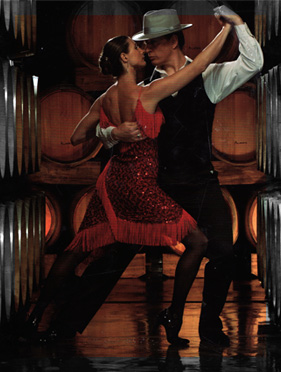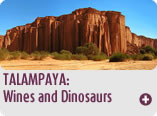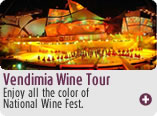
City of Buenos Aires tours
The City of Buenos Aires is the capital of the Argentine Republic and one of the more important tourist points of our country. Approximately 3 million people live in this city. Including the metropolitan area, the total population of Buenos Aires is above ten millions, making it one of the 10 most populated urban centers in the world.
The Río de la Plata river and the Riachuelo river are the natural borders of the city on the east and south, respectively. The rest of the metropolitan perimeter is surrounded by the General Paz Avenue from north to west. This avenue provides a fast connection between the city and the Greater Buenos Aires, a densely populated area with important business and industrial activity.
At the end of 2001, popular mobilizations engendered by the severe economic crisis and the siege ordered by President De la Rúa spread to the porteño downtown to converge in the Plaza de Mayo. The turn of the century was the time of the “cacerolazo” (people carrying cooking pots which they hit with energy) as a way of protest and of the arrival of the “piqueteros” (unemployed workers who block highways to ask for a job) to the Plaza.
Today, the Plaza de Mayo keeps on gathering demonstrators. From 2002, thanks to the increase in the number of tourists coming to the city, the Plaza full of people captures the attention of visitors. While crossing it, past history as well as history in action can be perceived.
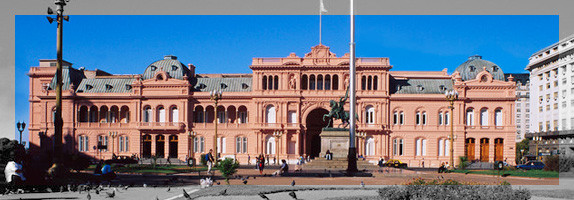
The Casa Rosada and The Plaza de Mayo.
Buenos Aires has always been an open-door city. Its inhabitants are called “porteños”, which makes reference to the fact that the city is a port. The inhabitant of the province of Buenos Aires is called “bonaerense”. Porteños are warm and hospitable.
The official language is Spanish. Something to note is the use of vos (you) instead of the Spanish “tú” for informal treatment, and the use of “che” to address a person. “che”: this expression is used to attract a person’s attention and allows addressing someone without using his or her name: “Che, ¿me podés decir la hora” (Che, could you tell me the time?). It expresses familiarity.
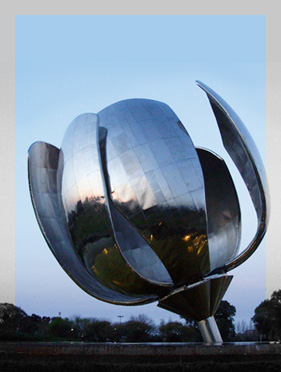 Sculptura of The Rouse. Naciones Unidas Square.
Sculptura of The Rouse. Naciones Unidas Square.
The “porteños” easily understand persons who speak Italian and Portuguese. Most people involved in tourist activities speak English.
Tango in Buenos Aires
The tango comes from the milonga and other countryside rhythms. It was originated by 1880 in the first suburb of Buenos Aires: San Telmo neighborhood today. Since then until the 50s, the tango experienced a great evolution. Almost all Buenos Aires people become experts and may reproduce in their memory the most complicated arrangements and at the same time dance these renovated tango music. Since the 60s, this music slowly begins a standstill phase which will last approximately until decade 90. However, in the last years, Buenos Aires music becomes again firmly popular. The young public entered now in scene to remember and to clap renown figures of the old tango music. Tango courts multiplied at the rhythm of the dancers. New orchestras knew how to combine tradition and modernity.
|
“Milongas” and “Tanguerías”
Milonga is the ballroom were tango is danced (also waltz and milonga -one of the tango rhythms- are here danced). Buenos Aires tango followers go to dance almost every night. They usually go to more than one place every night. In Buenos Aires, reaching the end of 2007, there are more than 70 milongas. Some are elegant, other informal ones. In almost every milonga, dance schools operate..
Tanguerias are saloons which follow the international ‘dinner-show’ format.
These saloons present an acrobatic tango style. More than 20 tanguerias in the city offer shows: tango with a sophisticated choreography and professional dancers. The orchestras —generally formed by excellent musicians — usually play the most famous songs.
Buenos Aires: passion for the football
What should you recommend to travelers?
To take into account a list published by the English newspaper, "The Observer", three or four years ago including the 50 sports events you should watch before dieing. A football match between Boca-River at the ‘Bombonera’.
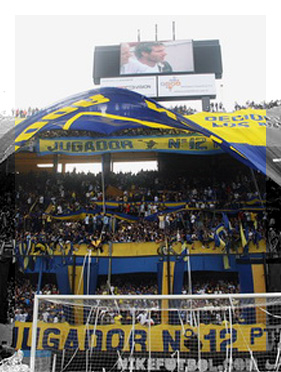 "La Bombonera"
"La Bombonera"
Argentineans vibrate and show their passion for this sport. The stadiums of Boca Juniors (Bombonera) and River Plate (Monumental), which belong to the two most important clubs of the country, are in Buenos Aires. Visiting them and, above all, going to see a soccer match is an unforgettable experience that sums up the feelings of people from Buenos Aires and from all Argentina.
Puerto Madero and La Boca. The new and traditional districts in Buenos Aires.
The descendants of immigrants gave color to La Boca, the most emblematic symbol of the immigration process of early century XX . There Alfredo Palacios, the first Socialist Representative from America, was elected in 1904.
The tango had and still has its meeting points. There, in La Boca, Francisco Canaro formed his first orchestra, and its tango places are as good as its Italian restaurants.
Many of the most important Argentine painters lived and worked in La Boca. From Quinquela to Cúnsolo, Victorica, Lacámera, Daneri, and more recently Leopoldo Presas and Rómulo Macció. There are superb museums, like the Museo de Bellas Artes or the new one of Proa. La Boca keeps its great symbols as the Puente Transbordador from 1914. In its streets you can still visit such classics as Café La Perla, La Pizzería de Banchero, Teatro de la Ribera, Grupo de Teatro Catalinas, Omar Gasparini’s dolls I honor of Maradona, Tévez and typical characters, the legendary volunteer firemen, etc.
|
Puerto Madero has been born during past 90s after an important transformation of Buenos Aires Port, which was dedicated to civil activities and today it is the symbol of modernity in the city. It has been added to the zone new hotels, buildings and skyscrapers and now it´s called with "the Manhattan Porteño" nickname.
The possibility of joining both districts in one tourist strip is an idea that lightens up the soul.
Buenos Aires and its architecture
The first recommendation for someone who visits Buenos Aires is to walk around looking up. He/she will find an exotic and varied architectural world.
From an architectural point of view, there is a group of buildings in Buenos Aires that are the most significant and famous: the “Teatro Colon,” the “Palacio de Aguas Corrientes,” the “Iglesia del Pilar,” the “Catedral Metropolitana,” the “Casa Rosada,” and the “Palacio Legislativo,” among many others which are part of the wealth and memory of the city.
The recommendation is to guide yourself with the architecture map of Buenos Aires with the 50 most important buildings. (It is on sale at 562 Corrientes Avenue).
 Puerto Madero.
Puerto Madero.The “Plaza de Mayo” (Square of May) and the political history of Argentina
Plaza de Mayo is the historical heart of the city; it is surrounded by the Cabildo, the Casa Rosada (Pink House, seat of the National Government), the Cathedral, the Bank of the Nation, the seat of the Buenos Aires Government, among other public buildings.
Moreover, it is the centre of the most important civic events and the space where the most significant public demonstrations have taken place. Civic participation is one of the special features and appeal of the city.
It was in this Plaza that a crowd of people managed to free Colonel Perón in 1945; in the same place, another crowd celebrated his overthrow in 1955. It was also in this Plaza, in 1977, where a group of brave mothers started a march –yet unfinished- to claim for the life of their children. It was here that thousands of people applauded the invasion of the Islas Malvinas (1982), and others were suppressed when the war ended in defeat. In the Plaza de Mayo, more than a million citizens celebrated the return to democracy (1983) and defended it many times against the arrogance of the authoritarian people.
Cultural Buenos Aires
Buenos Aires is one of the worldwide capitals of the theatre. The “porteño” audience –of great dramatic tradition– consume the most dissimilar genres: classical national plays or meticulous versions of international successful plays; the most classical musical comedy or the most avant-garde individual plays.
Many of these plays are dramas, but it is also typical of Buenos Aires the “Teatro de Revista”, light vulgar humour plays with comedians and cabaret stars.
Another important cultural aspect of Buenos Aires is given for its great amount of bookstores. They can be big and luxurious on the main avenues, discount, or sell antique books in the suburbs. Their appeal for tourists is in the history they represent and the cultural and leisure space they offer. Visiting the bookstores in Buenos Aires, searching their shelves, talking to their booksellers, are ways to know and understand the city and its traditions.
![]()
![]()






